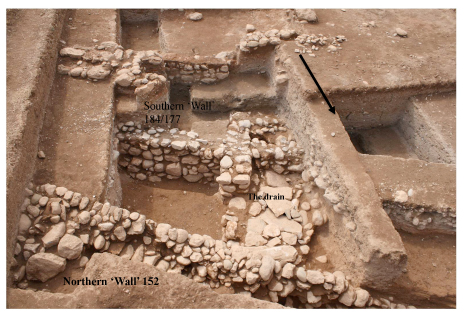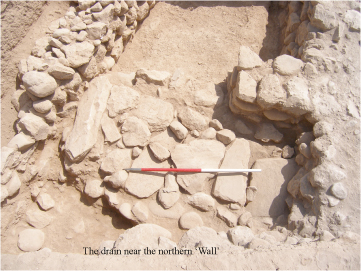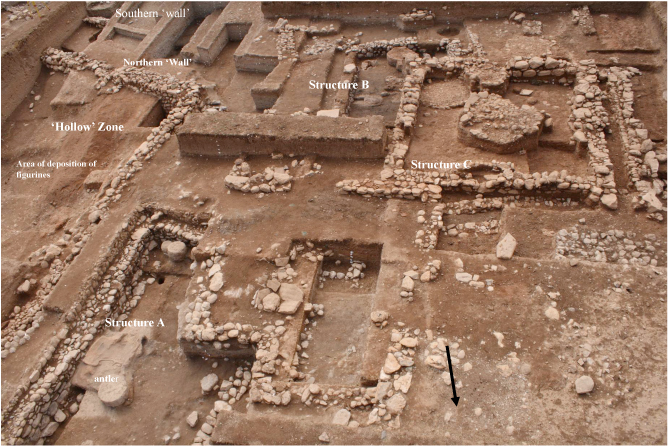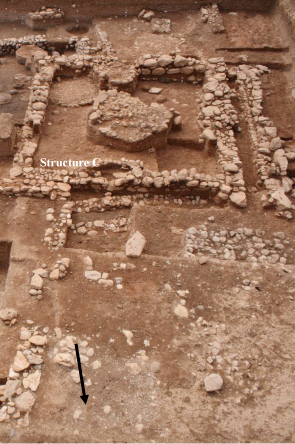|
|
|
LEFKANDI-XEROPOLIS 2008 SEASON– Region II
There were two major zones of enquiry: (1) the complex of walls defining the ‘hollow’ zone to the North and East (Areas R and S), and (2) the series of Structures to the West (Areas T and U).
The ‘Walls’ These ‘Walls’ appear to be a complementary series of straight, long-running wall-lines which defined the West and South edges of the 'hollow' zone. It is suggested that they may delineate the area through which the site was entered from the North across the low land isthmus and between the possible two lagoons to the East and West of Xeropolis (see earlier reports especially that of 2005). A system of two parallel lines is at present perhaps the most economical way of interpreting the evidence even if it is necessary to make a number of assumptions about the now almost completely vanished walls. Further excavations are required here to verify any such suggestions. It is tempting to call them some kind of ‘city-walls’ thought they are not as substantial as is common with other known examples (see for example the wall of a Late Helladic IIIC discovered in the area of the Metropolis on Naxos).
It is apparent that more investigation is needed in this area before we can fully appreciate the different phases of construction but also the precise function of the ‘Walls’. It is noticeable that the Northern 'Wall' does continue further to the East (into land we do not own). But the extent of the area marked by the 'Wall' or 'Walls' to the North/East of Region II is uncertain, as is whether the 'ritual' deposit discovered in 2006 and 2007 was also extended further to the East. It is hoped that future investigation will shed light on this important area and reveal more of both its functional and 'ritual' purposes. The ‘Ritual’ zone This term is employed for convenience at this preliminary stage of reporting this year’s excavation: the nature of the discoveries is, by known local terms of reference, neither domestic nor funerary. The possibility of a possible industrial aspect is also being investigated. Thus, the term must be regarded only as a working hypothesis. What is clear, however, is that during the course of this season, the complexity and continuity of this quarter began to appear. Three particular areas are presented below in more detail.
STRUCTURE A This is the earliest yet recorded in the area: its construction is in LH IIIC (Lefkandi-Phase 1). The irregularity of its form and the different wall types point to a complicated structural history. The report below should be considered only preliminary. Two main floor surfaces were recorded – mainly of yellow clay. They were separated by a thin layer of mostly intensely carbonized soil (probably not associated with a destructive fire). Above the second floor a thicker mix of such with pisé elements was observed. The furniture in the rooms is highly distinctive. Two yellow clay drums, of different heights are associated with the first floor. They are set against the middle of the South wall, and a red-brown clay-bin is similarly placed against the North wall. In the second phase, another and larger yellow clay drum was set in the middle of the room, on the same N/S axis, and with it was found a large and shallow receptacle made of reddish clay (not well fired). On top of the supporting surface for the receptacle, and within its limits, on an E/W axis, was carefully set a magnificently complete and large red-deer antler. Good numbers of complete vessels turned up in the S/E area in particular. The East and South walls may show evidence of a second phase in their very uppermost courses. Two large pits much disturbed the western side. One of them had good Lefkandi Phase 1B wares in it. STRUCTURE B This is partly overlaid at its N/W by Structure C. It is a rectangular building (4.6 x 3.75 m), set on the excavation grid-lines. Its form is quite different than Structure A and akin to Structure C, but its internal furniture and depositional story resemble that of Structure A rather than Structure C. An intermediate position in both time and type is indicated: a useful indication of continuity between the three structures and thus for the region as a whole. The walls of Structure B are again subject to different modes of construction: those on the West and South (Walls 204 & 203) have deeper stone socles for supporting mudbrick than those on the North and East (Walls 219 & 220). Potential openings are seen in the North, East and South walls. The internal furnishings include a very large red clay drum, placed against the middle of the South wall, just to the right of the postulated entrance. To this a rectangular platform of reddish mudbrick/clay stretching to the N/W was added later. Half way along the East wall is a ?-shaped arrangement of mudbricks set on their edges, within it was a very shallow deposit of fine grey 'ashy' soil. Finally in roughly the centre of the room is the remains of a collapsed red-clay drum. STRUCTURE C This is the latest of the Structures discovered to date. A roughly 5 m square on the excavation grid, it overlies both Structure B and the SW/NE orientated wall-lines (see above). Its internal furnishing and depositional story are quite different from Structure B: instead of clay drums and dark carbon-laden soils it was found to contain circular 'platforms' made of different sizes of stones and pebbles. At present we call those ‘features’. These ‘features’ are very distinct: a shallow rounded hollow was formed; its edge ringed with stones of medium size to form a kerb, within which similar and smaller stones were laid to make a close-packed ring. Then ever smaller stones, pebbles and near-gravel are sequentially scattered to fill up the cracks. No ash, burning or bones are associated with them. Indeed signs of carbon are essentially absent. A number of spindle whorls and a few pendants were the only finds. Finally, the associated pottery would place the use of Structure C between late in LH IIIC and the Middle Protogeometric period. The purpose of the Structures is not yet entirely clear. More excavation is certainly required. At present we assume that the whole area associated with the 'Walls' was devoted to some kind of ritual activity. The recovery in Area R and to the North of the 'Walls' of a number of high quality figurines in 2006 and 2007 may suggest that they – before their 'ritual deposition' – could have come from the so-called ritual area to the West. Clay drums and circular platforms are known in the literature but do not appear together at the same site. They are associated with ritual or funerary contexts. It may be that here the platforms replaced the drums. Interestingly the offering of the antler in Structure A matches a similar find in the so-called Temple complex at Mycenae (Phase VIII: LH IIIB). Moreover, it is noticeable that the ceramics discovered to the East of and outside Structure C include large to monumental sized craters and cooking pots which were found together with a lot of animal bones. The cooking appears to have taken place where the pots were found. This is evidence of eating and drinking taking place outside but close to Structure C. An alternative suggestion is that the whole area was dedicated to workshops for processing of olive oil or wine. In this case the clay drums might have served as rests for the vessels in which olives or grapes were crushed with receptacles set lower on the floor or on another drum nearby. There are, however, difficulties with such an interpretation. The spaces which have been excavated so far are too small to accommodate such activities. It is also harder to interpret the circular Features (or platforms) in the same way as they seem mostly set at ground/floor levels. Nevertheless, in order to resolve this further, samples have been taken from the dark soils and from the clay drums for testing. The residues from the environmental samples will be further scrutinized for pieces of any fruits discarded.
Home > New Excavations> 2008 Season >2008 Season Region II> 2008 Region I
Copyright © 2009, http://lefkandi.classics.ox.ac.uk/ |



 Yet, though not very high – even when topped with mudbrick – they would have been more impressive when viewed from below and when ascending any ramps or stairs of the entrance. The date of their earlier phases requires study but should be primarily within the LH IIIC. In the Early Iron Age, only parts of the so far excavated parts of the ‘Walls’ appear to have been used.
The best evidence for reconstructing the sequences in the use of the dual ‘Walls’ was found in the east of Area S (Walls 152 & 184). Both were rebuilt several times and the southern ‘Wall’ at the end changed its orientation. The reason for this extensive work is not clear, but in addition a North/South drain was inserted in this area, and a small entrance way was opened through Wall 152.
Yet, though not very high – even when topped with mudbrick – they would have been more impressive when viewed from below and when ascending any ramps or stairs of the entrance. The date of their earlier phases requires study but should be primarily within the LH IIIC. In the Early Iron Age, only parts of the so far excavated parts of the ‘Walls’ appear to have been used.
The best evidence for reconstructing the sequences in the use of the dual ‘Walls’ was found in the east of Area S (Walls 152 & 184). Both were rebuilt several times and the southern ‘Wall’ at the end changed its orientation. The reason for this extensive work is not clear, but in addition a North/South drain was inserted in this area, and a small entrance way was opened through Wall 152.
